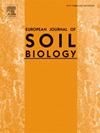Soil potentially toxic elements promote carbon metabolism in alpine meadows on the Qinghai-Xizang Plateau
IF 3.3
2区 农林科学
Q1 ECOLOGY
引用次数: 0
Abstract
Potentially toxic elements (PTEs) of soil are crucial for sustaining the equilibrium of grassland "vegetation-soil-microorganism" systems and influencing terrestrial biogeochemical cycles. This study investigated how PTEs influence microbial community structure and carbon metabolism by comparing soil microbial differences under fencing enclosure (FE), winter grazing (WG), and artificial unicast oat (AU) management practices. This was done in alpine meadows using metagenomic sequencing techniques. The results indicated that management measures significantly changed the distribution of the Cr, Hg, and As, with Cr and As being the highest in AU and Hg being the highest in FE. In the purine metabolic pathway, Hg had a significant positive effect on soil microbial biomass carbon (SMBC) metabolism, which was catabolized by the prokaryote Chloroflexi and the fungal organism Chytridiomycota during guanosine triphosphate (GTP) catabolism and xanthosine monophosphate (XMP) synthesis to promote soil SMBC cycling. Cr had a significant negative effect on soil organic carbon (SOC) and SMBC metabolism during the synthesis of xanthonsine, urate, 5-hydroxy-2-oxo-4-ureido-2,5-dihydro-1H-imidazole-5-carboxylate and CO2. Additionally, the enrichment and decomposition of Cr by the prokaryotic organisms Proteobacteria and Verrucomicrobia, inhibited SMBC and SOC transformation and affected soil CO2 emissions. Further, by comparing resistance genes, it was found that alpine meadows were more resistant to Hg and Cr and that fungal organisms were more tolerant to Cr than prokaryotes. Overall, Cr and Hg interact with microorganisms to influence SOC and SMBC metabolic processes and have a positive effect on carbon sequestration in alpine meadows.
青藏高原高寒草甸土壤潜在有毒元素促进碳代谢
土壤潜在有毒元素对维持草地“植被-土壤-微生物”系统平衡和影响陆地生物地球化学循环至关重要。本研究通过比较围栏(FE)、冬季放牧(WG)和人工单播燕麦(AU)管理方式下土壤微生物的差异,探讨了pte对微生物群落结构和碳代谢的影响。这是在高山草甸中使用宏基因组测序技术完成的。结果表明,管理措施显著改变了Cr、Hg和As的分布,其中Cr和As在AU中最高,Hg在FE中最高。在嘌呤代谢途径中,Hg对土壤微生物生物量碳(SMBC)代谢有显著的正向影响,在三磷酸鸟苷(GTP)分解代谢和单磷酸黄嘌呤(XMP)合成过程中,汞被原核生物Chloroflexi和真菌生物Chytridiomycota分解代谢,促进土壤SMBC循环。在黄嘌呤、尿酸、5-羟基-2-氧-4-脲基-2,5-二氢- 1h -咪唑-5-羧酸盐和CO2的合成过程中,Cr对土壤有机碳(SOC)和SMBC代谢有显著的负影响。此外,原核生物Proteobacteria和Verrucomicrobia对Cr的富集和分解抑制了SMBC和SOC的转化,并影响了土壤CO2的排放。此外,通过对抗性基因的比较,发现高寒草甸对汞和铬的抗性更强,真菌生物对铬的耐受性优于原核生物。总体而言,Cr和Hg与微生物相互作用,影响高寒草甸土壤有机碳和SMBC代谢过程,对碳固存具有积极作用。
本文章由计算机程序翻译,如有差异,请以英文原文为准。
求助全文
约1分钟内获得全文
求助全文
来源期刊

European Journal of Soil Biology
环境科学-生态学
CiteScore
6.90
自引率
0.00%
发文量
51
审稿时长
27 days
期刊介绍:
The European Journal of Soil Biology covers all aspects of soil biology which deal with microbial and faunal ecology and activity in soils, as well as natural ecosystems or biomes connected to ecological interests: biodiversity, biological conservation, adaptation, impact of global changes on soil biodiversity and ecosystem functioning and effects and fate of pollutants as influenced by soil organisms. Different levels in ecosystem structure are taken into account: individuals, populations, communities and ecosystems themselves. At each level, different disciplinary approaches are welcomed: molecular biology, genetics, ecophysiology, ecology, biogeography and landscape ecology.
 求助内容:
求助内容: 应助结果提醒方式:
应助结果提醒方式:


